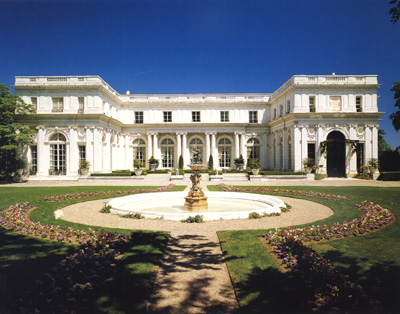This week was a busy one for architectural programming in Newport. On Wednesday, March 6 at Rosecliff, a panel was convened to discuss the state of the Newport Historic Urban Plan initiative. John Tschirch served as moderator and four of the project’s scholarly participants were on hand to talk about their discoveries and perspective now that they are twelve months into the project. Christina Connett, a professor of cartography at RISD, has been engaged as the Lead Scholar.
Catherine Zipf, a professor of architectural and social history at MIT, John Hattendorf, a professor of history at the Naval War College, and Ron Onorato, professor of Architecture at URI, were all on hand to share their perspectives and thoughts on the work so far. Tschirch, who is serving as the Project Director, noted that there is still several years more work to do before the project is ready for public review but the ultimate goal is to provide an online database of historic maps, plans, and other materials that can be used by historians and planners alike to understand the Newport of the past and help direct the development in the city in the future. The project is being conducted with The Preservation Society serving as the coordinating organization and is being supported by a number of private grants.
Because of the blizzard on February 9, John Tschirch’s talk at the Newport Art Museum had been postponed until Saturday, March 9. Adding to the winter lecture series by one week, John Tschirch’s talk, “New lessons from Old Cities”, overlapped with the earlier panel only slightly as it was mostly focused on the evolution of the city plan from the early Roman period, through the development of Rome to the walled cities of the middle ages to Baron Haussmann’s redesign of Paris to the laying out of Philadelphia by William Penn. In his engaging slide presentation, Tschirch took the near-capacity crowd through a whirlwind tour of historic cities pointing out their strengths and weaknesses. He concluded that although each city is unique, the things that make cities great are walkability, places for social interaction and spectacle, and a sense of Polis — the ownership that residents take in being part of their specific community. Tschirch credited the Historic District Commission and the Aquidneck Land Trust for each helping pull the city in a positive direction — one in the direction of preserving great buildings of the past and the other working to create green, open spaces where appropriate.
The month is by no means finished with events that will be of interest to planners, historians, and those interested in landscape design. On the evening of Thursday, March 21, The Preservation Society is hosting the Noreen Stonor Drexel Lecture entitled: Considering Cultural Landscapes, Design & Historic Preservation Together. This will be delivered by Charles Birnbaum, (FASLA, FAAR) who is the Founder and President of the Cultural Landscape Foundation. Birnbaum will be speaking about the importance of landscapes as part of a broader historic preservation effort in general but may provide a particular focus on the rugged beauty of Ocean Drive and the pristine quality of Bellevue Avenue estate gardens and the many other landscape elements that help give Newport it’s unique importance and character. As registration for this event is limited call 847-1000 x154 to reserve your place soon as the place will soon be gone! While it is still cold outside, take advantage of some of the wonderful opportunities to learn more about Newport’s architectural and design heritage in the comfort of a warm room in one of our city’s great architectural marvels!
Looking to remodel your home? Let’s connect.
Join the Architectural Forum to stay up-to-date with architectural news from Rhode Island and abroad.
Ross Sinclair Cann, AIA, LEED AP, is a historian, urban planner, educator, and practicing architect living and working in Newport. This article was initially published in ARCHI-TEXT, in Newport This Week, March 10, 2013.
